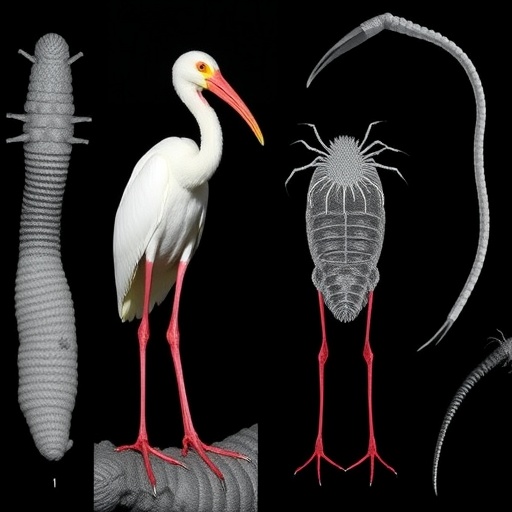A captivating new study has emerged in the field of parasitology, shedding light on the complex and often overlooked relationship between migratory birds and their parasitic trematodes. Researchers in Turkey have undertaken a rigorous morphological and molecular examination of trematodes infesting two species of storks, the White Stork (Ciconia ciconia) and the Black Stork (Ciconia nigra). This comprehensive investigation unveils critical insights into parasite biodiversity, host specificity, and the implications for both avian health and ecosystem dynamics.
Storks, iconic for their elegant flight and seasonal migrations across continents, have long fascinated ornithologists and ecologists alike. However, their parasitic fauna, particularly trematodes—flatworms within the phylum Platyhelminthes, known for complex life cycles and significant health impacts—have remained understudied. In their new publication, Öztürk and Umur have meticulously detailed both the morphological traits and molecular signatures of trematodes harvested from stork populations in various Turkish habitats, an approach that bridges classical taxonomy with cutting-edge genetic tools.
The research emphasizes the importance of integrating morphological observations with DNA-based techniques to accurately delineate trematode species. Traditional parasitology often hinges on structural features visible under microscopy, but phenotypic plasticity and convergent evolution frequently complicate species identification. By employing molecular markers such as mitochondrial and ribosomal DNA sequences, this study corroborates and refines morphological findings, providing a robust framework for taxonomy and evolutionary studies.
Results indicate a diverse assembly of trematode species colonizing the digestive tracts of both Ciconia species, highlighting both shared and unique parasite-host relationships. This diversity reflects ecological interactions shaped by host migratory routes, feeding habits, and habitat preferences. The White Stork, often found in a wider range of wetland environments, harbors a slightly different trematode community compared to the more elusive and forest-associated Black Stork, suggesting ecological specialization and co-evolutionary dynamics.
Importantly, the molecular data reveal cryptic species within previously recognized trematode taxa, underscoring the limitations of morphology alone in parasitological diagnostics. Such cryptic diversity has profound implications for understanding parasite transmission, host susceptibility, and the evolutionary pressures shaping parasitic adaptations. Detecting these cryptic lineages contributes to more accurate assessments of biodiversity and parasite-host coevolution.
The study also probes the pathological effects of trematode infections on stork populations. While parasitism is a natural phenomenon, heavy infestations can impair nutrition, reproductive success, and overall fitness of avian hosts. Molecular identification of trematode species aids in pinpointing which parasites pose the greatest threats, potentially guiding conservation efforts aimed at vulnerable stork populations, especially in the face of habitat alteration and climate change.
Furthermore, this research enriches our comprehension of trematode life cycles, which typically involve multiple intermediate hosts, such as mollusks and fish, before reaching avian definitive hosts like storks. Understanding these cycles is pivotal for anticipating and managing parasite spread, particularly as migratory birds traverse multiple geopolitical regions and diverse ecological niches.
The revelations from Turkey’s stork trematodes highlight the broader significance of parasite ecology in migratory birds as sentinels of environmental change and One Health indicators. Parasites can act as bioindicators, reflecting the health of aquatic ecosystems and the integrity of food webs. This underscores an urgent need for continued surveillance and integrative parasitological research amid rapid global environmental transformations.
This study stands out for its detailed morphological illustrations paired with high-resolution molecular analyses, embodying a multidisciplinary approach. Such integration sets a benchmark for future parasitological studies on avian hosts, especially those with complex life histories and overlapping habitats. It opens doors for collaborative international research encompassing ecology, genetics, and wildlife conservation.
The implications extend into scientific policy and wildlife management, prompting considerations for controlling trematode transmission hotspots and safeguarding migratory corridors essential for stork populations. By unveiling the hidden parasitic landscapes within these common but ecologically vital birds, the authors contribute vital knowledge toward maintaining avian health and ecological balance.
Notably, the methodological rigor demonstrated in this research, including precise sample collection, DNA extraction protocols, PCR amplification, and sophisticated phylogenetic analyses, exemplifies advancements in parasitology. Coupling these with careful morphological taxonomy offers a replicable model adaptable to diverse host-parasite systems globally.
In sum, this pioneering investigation navigates the nuanced interface of parasite biology, avian ecology, and molecular systematics, elucidating complex trematode diversity within stork populations of Turkey. It not only solves taxonomic puzzles but also lays foundational work for understanding the ecological and evolutionary consequences of parasitism in migratory birds.
The study reaffirms the critical role of comprehensive parasite inventories in wildlife health assessments and biodiversity conservation. Future research inspired by these findings may explore parasite dynamics across spatial and temporal scales, the impact of environmental stressors on host-parasite interactions, and the genomic underpinnings of parasitic adaptation and virulence.
As the global community grapples with pandemics, biodiversity loss, and ecosystem shifts, such integrative parasitological insights assume heightened importance. They illustrate how microscopic parasites inhabiting majestic storks symbolize broader ecological narratives that intertwine animal health, environmental stability, and human well-being.
This research not only enriches academic understanding but possesses the viral potential to captivate public imagination by revealing the invisible yet intricate biological relationships that sustain planetary biodiversity. It spotlights how a seemingly niche focus on trematodes illuminates grand themes of evolution, ecology, and conservation science.
Subject of Research: Morphological and molecular characterization of trematodes infecting stork species (Ciconia ciconia and Ciconia nigra) in Turkey.
Article Title: Morphological and Molecular Study on Trematodes of Storks (Ciconia ciconia and C. nigra) from Turkey
Article References:
Öztürk, M., Umur, Ş. Morphological and Molecular Study on Trematodes of Storks (Ciconia ciconia and C. nigra) from Turkey. Acta Parasit. 70, 201 (2025). https://doi.org/10.1007/s11686-025-01139-3
Image Credits: AI Generated




